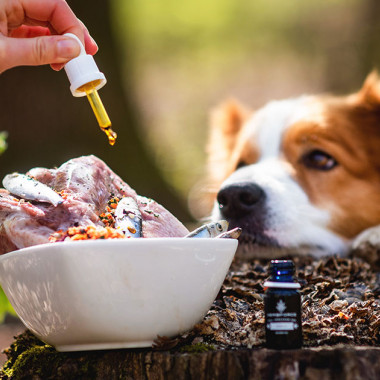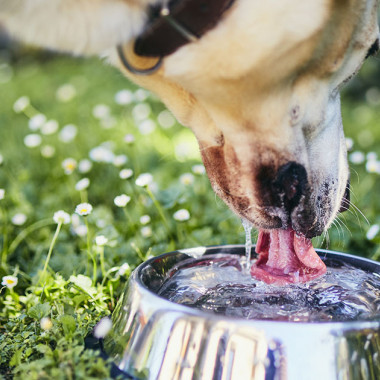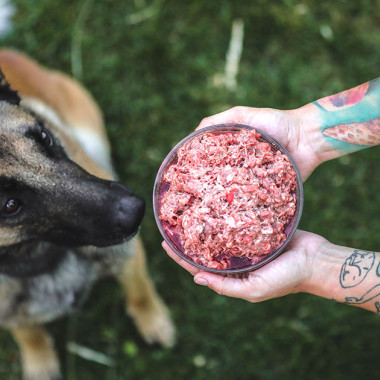Most people are familiar with how human taste buds work. But have you ever wondered how our four-legged friends perceive the taste of BARF food? Is it the same or completely different from how we experience flavors?
Taste is one of the five basic senses that every dog possesses. However, not all senses are fully developed at birth. In newborn puppies, only three senses are functional right after birth: taste, smell, and touch. Taste is an extremely important sense for survival and is also the first sense to become fully developed in a puppy. At this stage, the ability to taste needs to be well-developed. What a puppy tastes in early life, or how mother's milk tastes, influences its future flavor preferences.
How does it work?
Taste is recognized by the body through receptors on taste cells, which respond to the chemical composition naturally present in food.
These taste cells work similarly to olfactory cells, but their numbers vary significantly. The ratio of taste cells between dogs and humans shows surprising differences. The average human has approximately 9,000 taste buds, while a dog only has about 1,700. The higher number indicates greater sensitivity, which means that humans perceive flavors much more strongly, but in terms of smell, it's quite the opposite. For comparison, cats only have 470 taste buds.
The lifespan of taste cells is short, lasting only a few days. Once the old taste cells die off, new ones quickly form. Unfortunately, with age, all of an animal’s abilities weaken, and taste is no exception. As a dog gets older, the ability to create new taste cells becomes less efficient, resulting in a reduced sense of taste in senior dogs.
An animal's ability to recognize taste depends on its type of diet. Domestic dogs are classified as carnivores, though there’s room to debate their classification as omnivores with a focus on meat. The recognition of taste is species-specific, meaning that taste evolved to maximize survival in the wild.
Does it taste good or not?
For humans, it's easy—we can simply ask someone what flavors they prefer. Dogs, however, can't tell us this directly, so scientists have studied how dogs’ taste cells respond to different stimuli.
As previously mentioned, dogs are carnivores and naturally enjoy the taste of raw meat, and they can distinguish the taste of meat. But how does meat actually taste? The receptors on taste cells recognize taste based on the chemical composition of food. The chemical compounds in meat are called NUCLEOTIDES. Meat is made up of proteins, and the building blocks of proteins include chemicals. The most common chemical found in meat proteins is MSG—MONOSODIUM GLUTAMATE, a sodium salt. Because meat contains sufficient sodium compounds, dogs don’t feel the need to seek out salty foods and don’t need salt in their diet the way humans do. We, on the other hand, often feel the need to add salt to our food and enjoy salty snacks.
Which type of meat do dogs like the most? Scientists suggest that dogs prefer beef, pork, lamb, chicken, and even horse meat.
Although dogs are primarily attuned to meaty flavors, they can also detect other tastes, such as sweet, sour, and bitter.
How do dogs perceive sweetness?
Sweetness is detected by a chemical called FURANEOL, which is primarily found in fruits. This compound is also used in perfumes and flavorings, which can pose a danger to dogs if they ingest it. Just like people, dogs can develop a craving for sweet flavors. Unfortunately, due to their highly sensitive noses, they can sometimes be drawn to dangerous substances, such as antifreeze. Antifreeze contains glycol, which strongly appeals to a dog's sweet taste receptors. Even a small amount of ethylene glycol can be fatal for a dog, leading to poisoning and death.
What about the rest?
Along with pleasant flavors like sweetness, dogs can also recognize sour and bitter tastes. However, they do not find these flavors particularly appealing. Bitter tastes, in particular, are quite repulsive to dogs. Trainers often use a dog’s natural aversion to bitter and sour flavors to discourage unwanted behaviors, such as chewing on objects. Bitter-tasting substances are sometimes applied to items as a training aid to prevent dogs from chewing things they shouldn’t.
Taste buds aren’t uniformly distributed across the tongue, and each part of the tongue is more sensitive to certain tastes. For dogs, the distribution of taste sensitivity is different from humans. Sweet, salty, and sour tastes are sensed on the sides of the tongue, while the back of the tongue is most sensitive to bitter tastes. Unlike humans, dogs can also recognize the taste of water, with receptors for water located at the tip of the tongue. This ability evolved to help maintain proper fluid balance in the body. The water taste receptors are constantly active, so dogs drink water with flavor as well.
Taste and smell work together in animals. A dog’s sense of smell is exceptionally well-developed, which is why foods with a strong, appealing aroma are more attractive to them. Wet foods are also more enticing because taste works better when flavors are dissolved in liquid. Temperature plays a role as well—warmer foods release stronger scents and flavors, making them more appealing to dogs.
For dogs, it's natural and intriguing to explore new tastes because they can relate new flavors to those they've already experienced. A dog’s flavor preferences are shaped by what they consumed while nursing from their mother, as well as the environment in which they were raised. Dogs tend to prefer tastes associated with feelings of safety and comfort from an early age.










